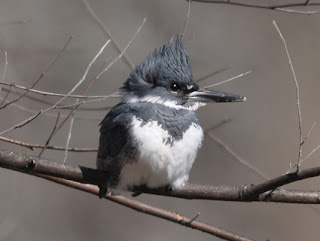 |
| Methow River, just south of Winthrop, WA. Photo by Kelly Wohlwend |
Even if you may think you won't need them, I would suggest bringing them. For example, I went camping for two days in Eastern Washington on the Methow River. Wanting to pack lightly I decided to leave my binoculars and field guide at home. Little did I know the Methow River and surrounding areas are excellent birding habitat.
In this post I will share some of my birding stories from this trip (including an encounter with a great horned owl!) and list the species I was able to identify at three separate locations: near my campsite along the Methow River, Beaver Pond by Sun Mountain Lodge and Patterson Lake.
Bird Counts
(Note: these are not all the birds I saw. This is a list of the birds I was able to identify without my binoculars or field guide. I did, however, have a good camera with me with a zoom lens, so I was able to take photos of most of the birds and identify them at home. Remember your binoculars!).
Key: A Visual ID means I saw the bird and visually identified it. Audio ID means I heard the bird and identified the bird based on its vocalization. An asterisk (*) means that I have never seen this bird in nature and it is a first time sighting!
Methow River, ~2 miles south of Winthrop
 |
| Lewis's woodpecker, photo by Kelly Wohlwend (author) |
- Belted kingfisher (Audio and Visual ID)
- Steller's jay (Audio and Visual ID)
- American robin (Audio and Visual ID)
- Tree swallow (Visual ID)
- Brewer's blackbird (Visual ID)
- Osprey (Audio ID)
- Common merganser (Visual ID)
- Cedar waxwing (Visual ID)
- Lewis's woodpecker* (Visual ID)
- Cassin's finch (Visual ID)
- Evening grosbeak (Visual ID)
- Northern flicker (Visual and Audio ID)
- American crow (Visual ID)
- Unknown warbler (Visual ID) (Based on the size of the bird and its colors (mostly yellow/green) it was either an orange-crowned warbler - Taiga version, female yellow warbler, or Wilson's warbler.)
- Black-capped chickadee (Audio ID) (Note: there may also have been chestnut backed chickadees. I didn't have any Visual ID's and both species sound very similar).
| Lewis's woodpecker, photo by Mike Wisnicki |
It is somewhat difficult to tell in the upper photo that I saw a Lewis's woodpecker. However, after observing the bird's feeding and perching behavior I knew it was a woodpecker. I watched these birds perch on a snag over the river and periodically fly out over the water, perform a few acrobatics and then fly back to the tree, sometimes perching vertically on the side of the trunk...just like a woodpecker. This feeding behavior is typical of Lewis's woodpeckers that generally do not search for insects by boring holes in trees but by snatching them out of the air (The Cornell Lab of Ornithology, 2011). Another feature that gave it away is the well-defined notch in the tail. In my photo I was also able to narrow down the species by its red face, gray collar and long beak.
The Methow River was a birding
hotspot! I couldn't believe the number
of birds I saw just along the river bank. The area of the river I camped
at only had a ~10 foot buffer with trees and shrubs between the campground and the river. This
buffer was equally small on the opposite side of the river, which was lined
with farms. It also seemed as if the birds were using the river as a
corridor. I watched common mergansers and other ducks travel up and
downstream, staying within the river's buffer. Other birds, such as the
belted kingfisher, also traveled up and down the river, diving for fish.
There was a massive amount of insects, which most likely accounted for the
high number of insectivorous birds in the area.
Our next stop...Beaver
Pond Trail near Sun Mountain Lodge
 |
| Great horned owl, photo by Kelly Wohlwend (author) |
- Great horned owl* (Visual ID)
- Merlin falcon (Visual and Audio ID)
- Spotted towhee (Visual ID)
- Black-capped chickadee (Visual and Audio ID)
- Red-breasted nuthatch (Audio ID)
- Juvenile wood duck* (Visual ID)
- Osprey nest (no birds present, photo below)
 |
| Osprey nest, photo by Kelly Wohlwend |
 |
| Great horned owl, photo by Kelly Wohlwend (author) |
 |
| Merlin falcon, Taiga subspecies, photo by Kelly Wohlwend |
 |
| Photo by Christopher L. Wood |
 |
| Photo by Cameron Rognan |
Last stop...birding on Patterson Lake
 |
| Male belted kingfisher, photo by Ed Schneider |
 |
| Common raven, photo by Chuq Von Rospach |
- Great blue heron
- Belted king fisher
- Common raven
- Canada geese
My exciting birding journey in the Methow Valley was made even more memorable as I was serenaded to sleep by the "hoot hoot" of the great horned owl's song on my last night in Eastern Washington.
Thank you for following me on my journey around the Methow River Valley. I hope my adventures encourage you to explore these amazing habitats. Remember, don't forget your binoculars or field guide!
References:
Sibley, Allen D. 2003. The Sibley Field Guide to Birds of Western North America. New York: Alfred A. Knopf. 471 pp.
The Cornell Lab of Ornithology, 2011, http://www.allaboutbirds.org

No comments:
Post a Comment